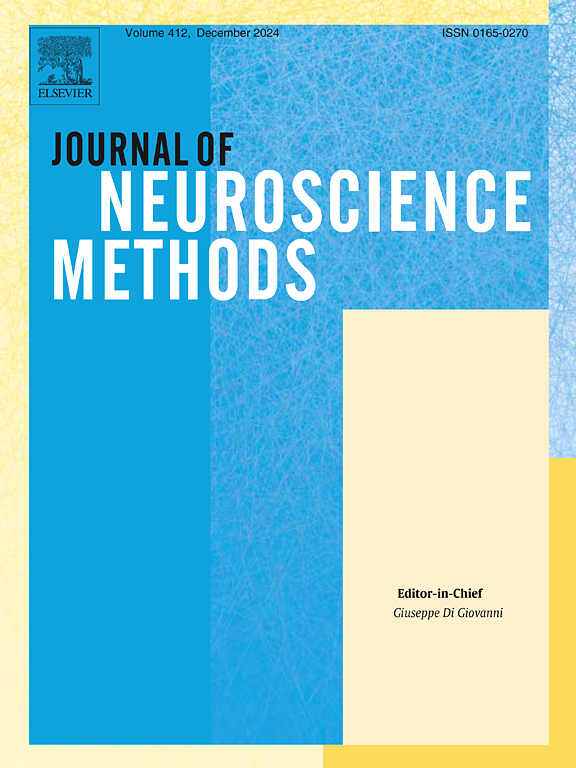Two-brain microstates: A novel hyperscanning-EEG method for quantifying task-driven inter-brain asymmetry
IF 2.7
4区 医学
Q2 BIOCHEMICAL RESEARCH METHODS
引用次数: 0
Abstract
Background:
The neural mechanisms underlying real-time social interaction remain poorly understood. While hyperscanning has emerged as a popular method to better understand inter-brain mechanisms, inter-brain methods remain underdeveloped, and primarily focused on inter-brain synchronization (IBS).
New method:
We developed a novel approach employing two-brain EEG microstates, to investigate neural mechanisms during symmetric and asymmetric interactive tasks. Microstates are quasi-stable configurations of brain activity that have been proposed to represent basic building blocks for mental processing. Expanding the microstate methodology to dyads of interacting participants enables us to investigate quasi-stable moments of inter-brain synchronous and asymmetric activity.
Results:
Conventional microstates fitted to individuals were not related to the different interactive conditions. However, two-brain microstates were modulated in the observer–actor condition, compared to all other conditions where participants had more symmetric task demands, and the same trend was observed for the follower–leader condition. This indicates differences in resting state default-mode network activity during interactions with asymmetric tasks.
Comparison with existing methods:
Hyperscanning studies have primarily estimated IBS based on functional connectivity measures. However, localized connections are often hard to interpret on a larger scale when multiple connections across brains are found to be important. Two-brain microstates offer an alternative approach to evaluate neural activity from a large-scale global network perspective, by quantifying task-driven asymmetric neural states between interacting individuals.
Conclusions:
We present a novel method using two-brain microstates, including open-source code, which expands the current hyperscanning-EEG methodology to measure and potentially identify both synchronous and asymmetric inter-brain states during real-time social interaction.
双脑微观状态:一种量化任务驱动的脑间不对称的新型超扫描-脑电图方法。
背景:实时社会互动的神经机制尚不清楚。虽然超扫描已经成为一种更好地了解脑间机制的流行方法,但脑间方法仍然不发达,主要集中在脑间同步(IBS)上。新方法:我们开发了一种新的方法,利用两脑脑电图微观状态来研究对称和非对称交互任务中的神经机制。微观状态是大脑活动的准稳定配置,被认为是心理处理的基本组成部分。将微观状态方法扩展到相互作用的参与者,使我们能够研究脑间同步和不对称活动的准稳定时刻。结果:与个体相适应的常规微观状态与不同的交互条件无关。然而,在观察者-行为者条件下,两脑微观状态被调节,与所有其他条件下,参与者有更对称的任务需求相比,在跟随者-领导者条件下也观察到同样的趋势。这表明在与非对称任务交互时静息状态默认模式网络活动的差异。与现有方法的比较:超扫描研究主要基于功能连接测量来估计IBS。然而,当发现跨大脑的多个连接很重要时,往往很难在更大的范围内解释局部连接。通过量化相互作用的个体之间的任务驱动的不对称神经状态,双脑微观状态提供了一种从大规模全局网络角度评估神经活动的替代方法。结论:我们提出了一种使用双脑微状态的新方法,包括开源代码,它扩展了当前的超扫描-脑电图方法,以测量和潜在地识别实时社交互动中的同步和非对称脑间状态。
本文章由计算机程序翻译,如有差异,请以英文原文为准。
求助全文
约1分钟内获得全文
求助全文
来源期刊

Journal of Neuroscience Methods
医学-神经科学
CiteScore
7.10
自引率
3.30%
发文量
226
审稿时长
52 days
期刊介绍:
The Journal of Neuroscience Methods publishes papers that describe new methods that are specifically for neuroscience research conducted in invertebrates, vertebrates or in man. Major methodological improvements or important refinements of established neuroscience methods are also considered for publication. The Journal''s Scope includes all aspects of contemporary neuroscience research, including anatomical, behavioural, biochemical, cellular, computational, molecular, invasive and non-invasive imaging, optogenetic, and physiological research investigations.
 求助内容:
求助内容: 应助结果提醒方式:
应助结果提醒方式:


